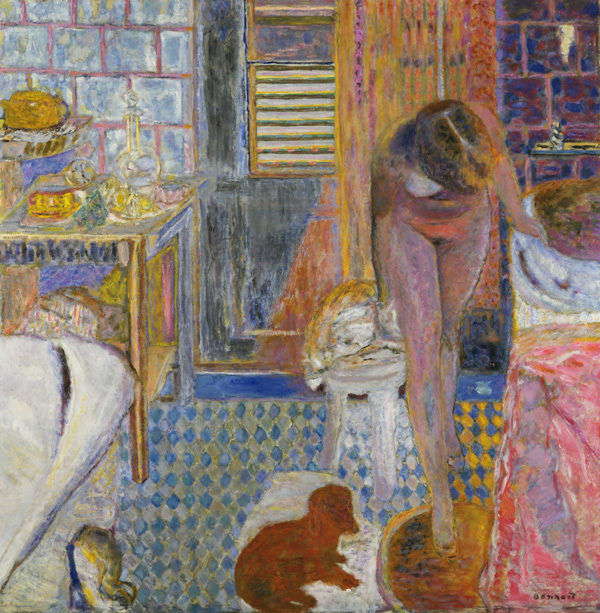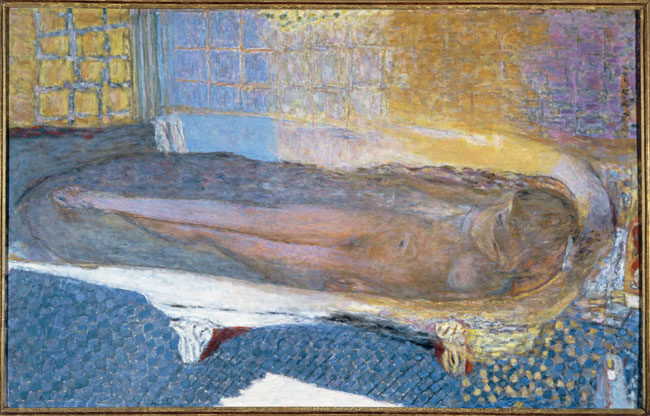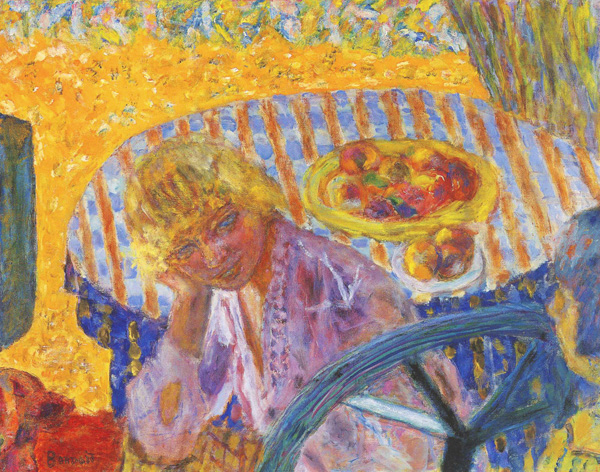Bed, Bath, and Bonnard
Jack Christian
January 2024
Pierre Bonnard, The Bathroom, 1932, oil on canvas. The Museum of Modern Art, New York.
Florence May Schoenborn Bequest, 1996 © 2023 Artists Rights Society (ARS), New York
1.
Pierre Bonnard’s bright domestic scenes are either a triumph over loneliness, or they are treatments of despair in all its colors. Probably they are both: so rich in color, so limited in scope. Seen in succession they call to mind illustrations for a high-end lifestyle catalogue. Bonnard’s is an art of materialism, one that seems to celebrate and to question how our lives are defined by the objects with which we surround ourselves. For this reason, the new Bonnard’s Worlds exhibition, which debuted in November at the Kimbell Art Museum in Fort Worth and will move to the Phillips Collection in D.C. in early 2024, could easily have been titled “Bed, Bath, and Bonnard.” The exhibition brings together 70 wildly colorful Bonnard paintings culled from his 50-year career, organized not chronologically, but by what its curators name “measures of intimacy.” This unique presentation strikes me as offering a chance not so much to understand Bonnard better, but for viewers to consider our ongoing attraction to his work.
The show begins with dreamy arcadian landscapes before spiraling through luxurious garden scenes, bucolic views out kitchen windows, and portraits from dining room, dressing room, and bathroom as viewers are funneled toward brooding portraits of Bonnard’s wife, Marthe de Maligny, depicted nude on the bed, and later, in the bath. Following the exhibition’s logic, one almost anticipates a climactic still-life of Marthe’s bellybutton. An offramp becomes necessary, and the self-portraits provide it, shifting viewers’ encouraged voyeurism onto Bonnard himself. Tastefully or skittishly, depending on one’s viewpoint, Bonnard’s Worlds concludes with three: Portrait of the Artist in the Dressing Room Mirror completed in 1945, two years before his death; The Boxer (1931), which portrays him in middle age with his dukes up; and Self-Portrait with a Beard (1920)¸ in which he appears younger, full-faced, handsome.
Pierre Bonnard, The Boxer (portrait of the artist), 1931, via Wikimedia Commons
These self-portraits shift the experience of Bonnard’s Worlds from the visceral to the conceptual as the exhibition’s focus swerves from the material to the cerebral. In this way, the entire exhibition makes for a sad, honest commentary on the smallness of Bonnard’s so-called worlds. His travels rarely take him further than his own yard. His self-portraits seem to acknowledge this stuck-ness. Visitors bedraggled by the memory of Covid-induced isolation might consider him a painter who spent his entire life on lockdown. But what a playful diversion he has made of that life! I think of Bonnard as a painter of sonnets, who, like Shakespeare, or his near American contemporary Edna St. Vincent Millay, locks himself into impossibly tight spaces, and then, with vibrant palettes and daring compression, battles his canvases into transcendence.
What kind of transcendence is hard to say. Bonnard accomplished so much in the bathroom, yet he remained there so obdurately. The trinity of large bathtub nudes presented penultimately in Bonnard’s Worlds are kaleidoscopic gems. Blue floor tiles swim into rainbow symphonies on the wall behind the tub. They create the feeling of closing your eyes in a sunny room, allowing the eyelid lightshow to dance across your daydreams. Marthe appears both human and spirit, a beige blob, positioned with her head beneath the faucet as if to gaze out an unseen window. When I viewed them, I liked the idea that in each—the three are nearly identical—Marthe is constructing her own mental collage that also collapses dimension and pattern, time and memory. Perhaps she’s thinking of Pierre as fondly as he seems to be thinking of her. Perhaps she’s thinking of something else.
One feels privileged and awkward viewing these scenes. Any more intimacy might melt us into puddles on the floor. We can’t stay here forever. Certainly we can’t stay here as long as Bonnard did in his inspired inhabitation of the privy. Squeamishness creeps in. “Keep in mind, he’s not actually in the bathroom painting these, but rather he’s painting from memory,” I overheard a docent tell her tour group after they’d lingered for a moment. In other words, try not to think of him sitting there like a weirdo on the toilet. In my case, when the unsaid suggestion meant I couldn’t stop thinking of him that way, I paused again before the self-portraits, where I then couldn’t keep from wondering: in his loneliness, in his myopia, is Pierre Bonnard “me”?
Pierre Bonnard, Nude in the Bath, 1936, oil on canvas. Musée d’Art Moderne de Paris. Purchased from
the artist for the 1937 International Exposition in 1937 © 2023 Artists Rights Society (ARS), New York
2.
This opening out of Bonnard’s worlds into our own is necessary if titling the exhibition Bonnard’s Worlds is meant to be taken as something other than a joke. Bonnard, after all, is a guy whose idea of a fun afternoon meant sketching his kitchen cupboard from odd angles, and who apparently found the entirety of his dining room table too expansive, opting instead to paint a corner of it viewed from the straight-down angle of a hasty snapshot—a Modernist innovation in the estimation of some historians, seemingly inspired by his early fondness for amateur photography.
So, what of this conflation of Bonnard’s worlds with our own? This theme exists in his paintings themselves and is accentuated by the Kimbell’s curation. In his most expansive landscapes, such as Steep Path at Le Cannet, he often adds himself, and sometimes Marthe, as figures who join viewers in imbibing his embellished scenes. Early in his career these come from his country house outside Normandy. Later, during World War II and the Nazi occupation of Paris, they are views from his house and studio in the south of France. On the whole, his outdoor paintings enact an impulse relatable to Americans: the attempt to cultivate a backyard Arcadia, to locate Eden in our own limited surroundings. Bonnard is wealthy enough to hide from the war at a country estate. This privilege allows his imagination seemingly to triumph against an unseen backdrop of violence and evil. But, present-day enjoyment of these images begs an inevitable question: from what are we hiding, in our lawn chairs, behind 10-foot privacy fences?
The inability, or unwillingness, to answer such a question helps explain why critical interpretation of Bonnard’s output remains unsteady more than 75 years after his death. He has been presented as a Late-Impressionist and, more recently, an Early-Modernist, but he is found wanting on both counts. As an Impressionist he seems lackadaisical; as a Modernist he appears overly safe. All along, critics have attempted to parse his terse diary, as if answers might be found in the entries of a man who typically described the day’s weather in two words or less, and who makes almost no mention of the world wars that bookend his career. In this pursuit, much has been written about his nearly 50-year cohabitation with Marthe, and also his seven-year affair with his model, Renée Monchaty, whose suicide after Bonnard rejected her in favor of marrying Marthe, bisected it.
Pierre Bonnard, Young Women in the Garden (Renée Monchaty and Marthe Bonnard),
(ca. 1921–23, reworked 1945–46), via Wikimedia Commons
I found it interesting that the exhibition only mentions Renée in the text that accompanies Young Women in the Garden, in which she and Marthe both appear. She is also possibly the model for Bowl of Milk, which is displayed nearby the Young Women painting, but the accompanying caption alludes only to Marthe and makes no mention of Renée. Surely Renée was one of Bonnard’s “worlds,” both during their affair and in the trauma of her death, but the exhibition ignores her while devoting significant verbiage to Marthe. Is the Kimbell worried that evidence of Bonnard’s unfaithfulness would trouble viewers’ ability to transpose the painter’s domesticity with our own?
Overall, I appreciated the curators’ choice mostly to downplay Bonnard’s biography. It’s not that his life’s details are uninteresting; it’s just that Bonnard, as in his paintings, leaves us with bright patterns that seem more riddle-like the longer one considers them. Given this, critics’ attempts to understand his work, whether through the lens of art history or through biography, seem to provide alibis for our interest as opposed to insight. He painted cloistered worlds beautifully. To view them is to feel squeezed and mesmerized, both at once. On the one hand, they are imaginative victories over life’s demoralizing detritus. On the other, they are records of demoralization. As such, Bonnard’s paintings come very close to articulating the delicate concoction of determination, hope, boredom, and anguish with which present-day people of relative affluence persist through daily life.
In the middle of the exhibition, as I viewed The Palm, which shows Marthe on a terrace with a view of the town behind her, framed by a giant leaf, a man beside me said, “Doesn’t this one inspire a warm feeling in your soul?” and I agreed that it did. As Bonnard’s Worlds unfolded I wanted more and more to ask: What is this feeling? What constructs it? Is it moral? Is it good? It feels dangerous to ask this, in part for the fear that pressing too hard will reduce Bonnard to something akin to the Thomas Kincade of interwar France, revealing us as philistine in our enjoyment. For me, this fear peaked when, as I listened to the audio tour offered by the Kimbell, the narrator suggested that Bonnard “rewards viewers with hidden cats and dogs lurking on the periphery of his indoor scenes.” And there, sure enough, in the bottom right corner of Fruit and Fruit Dishes, is the brown snout of a dachshund interrupting the portrait in the same manner my own dog so often photobombs family snapshots. If his paintings function almost as pre-digital photo-filters, then is Bonnard best understood as a forebearer of Instagram, I wondered?
There is precedent for this dubiousness. André Gide, in an anecdote that begins the novelist Julian Barnes’ essay on Bonnard, describes the convoluted impulse that led him to bid on a Bonnard nude despite finding it “racy” and “badly put together.” John Banville, meanwhile, in his novel The Sea, presents a protagonist tasked with writing a book on Bonnard but who finds he has nothing to say. In Bonnard’s own lifetime, despite his success selling paintings to Europe’s elite, several contemporaries openly despised his work. Picasso was the meanest, calling his paintings “a pot-pourri of indecision” and rejecting him as “the end of an old idea, not the beginning of a new one.” 75 years on we can chalk up Picasso’s complaint to the vanity of small differences between rivals whose paintings converged around fin-de-siècle fragmentation of meaning, but who then followed separate trajectories. It’s the question of whether there is an idea at all that nags most. “The main subject is the surface,” Bonnard said of his own paintings in 1935. As we come to the end of capitalism’s fantasy of unlimited growth, which carries with it the end of the American myth, could it be Bonnard’s pursuit of oblivion that appeals to us now more than ever?
3.
Whatever the case, the Kimbell has asserted itself as a present-day champion of Bonnard. This championing began with the museum’s 2018 acquisition of Landscape at Le Cannet, a painting more than nine feet long and four feet tall, which, before its inclusion in Bonnard’s Worlds, hung alone on the left wall in the atrium of the famous Louis I. Kahn building. If the museum had a mantlepiece, Landscape at Le Cannet is the painting chosen to hang above it. I thought of this on my drive into Fort Worth, when Saturday morning fog added drama to the weak hills rising over the commuter enclave of Flower Mound, creating an uncanny similarity to Bonnard’s painting. Intuition tells me this uncanniness informed not only the Kimbell’s acquisition of the painting, but the prominence of its display. If you squint, Landscape at Le Cannet becomes a romantic vision of the American Southwest. It suggests the life Texas settlers both old and new might hope to claim and concoct for themselves. I could almost imagine it refigured as the backdrop of an ad for a Texas winery. On its website, the museum acknowledges Landscape at Le Cannet as the inspiration for the Bonnard’s World exhibition.
Pierre Bonnard, Landscape at Le Cannet, 1928, oil on canvas. Kimbell Art Museum. Acquired in
2018, in honor of Kay Fortson, President of the Kimbell Art Foundation, 1975-2017 © 2023
Artists Rights Society (ARS), New York
About Bonnard’s “worlds” a few things are clear. They are worlds without racial difference, and almost without any sort of otherness. Whether happy or sad, they are worlds of seclusion and privilege, as John Berger observed. They depict a libertarian utopia: a place without commitment, responsibility, or even, really, any neighbors. Bonnard’s Worlds suggests a historical and geographical progression by which Bonnard’s wallpapers become Joanna Gaines’ (of the HGTV hit show Fixer Upper) interior decorations. Both inhabit the mindset of the comfortable settler—Bonnard in Le Cannet, and Gaines in Waco, Texas, 100 miles south of Fort Worth—desiring to “fix up” daily life with romantic ideals of insular existence. In the present tense, Bonnard’s is an art for the country club, the gated community, and the homeowner’s association. It is an art that welcomes global warming, locally, for the lucrative chance to tend vineyards in the Texas highlands as has been done for centuries in the south of France.
Ultimately, Bonnard’s Worlds creates enchanting but uncomfortable spaces in which viewers are confronted with these resonances. The caption accompanying his 1940 painting In the Bathroom describes how “Bonnard depicts the room from below…from the bather’s vantage point, which becomes our own.” In this painting and many others, viewers stand before claustrophobic canvases that mirror our claustrophobic lives. We ask, who is that reflected in the globe of the overly large dining room chandelier, that person who is both party to the dinner conversation and also aloof, that person who appears alienated in his own house, that monad who can prosper materially only within a larger theater of suffering?
The several hundred people viewing Bonnard’s Worlds alongside me were not just overwhelmingly white, but nearly completely white. This in the city of Fort Worth that is 19% Black and 35% Latinx. I left the exhibition moved by Bonnard’s attempted consolation for our segregated existences and existential emptiness. I left feeling it was only consolation. By then I was also certain that Picasso was correct about Bonnard representing the end of an idea, but unlike Picasso I didn’t blame Bonnard for it. The masterpieces gathered in Bonnard’s Worlds are spectacularly disconcerting. They suggest it is we who are at the end of an idea, and it is we who have held on too long.
Bonnard’s Worlds
November 5, 2023–January 28, 2024
Kimbell Art Museum
3333 Camp Bowie Boulevard
Fort Worth, Texas
◊
Jack Christian, is an arts and culture writer, and creative writing professor, living in Denton, Texas. Recently, he’s written about JMW Turner for Artforum, the Marfa Invitational Art Fair for Cleveland Review of Books, and about ongoing efforts to remove Confederate Monuments for Los Angeles Review of Books.





